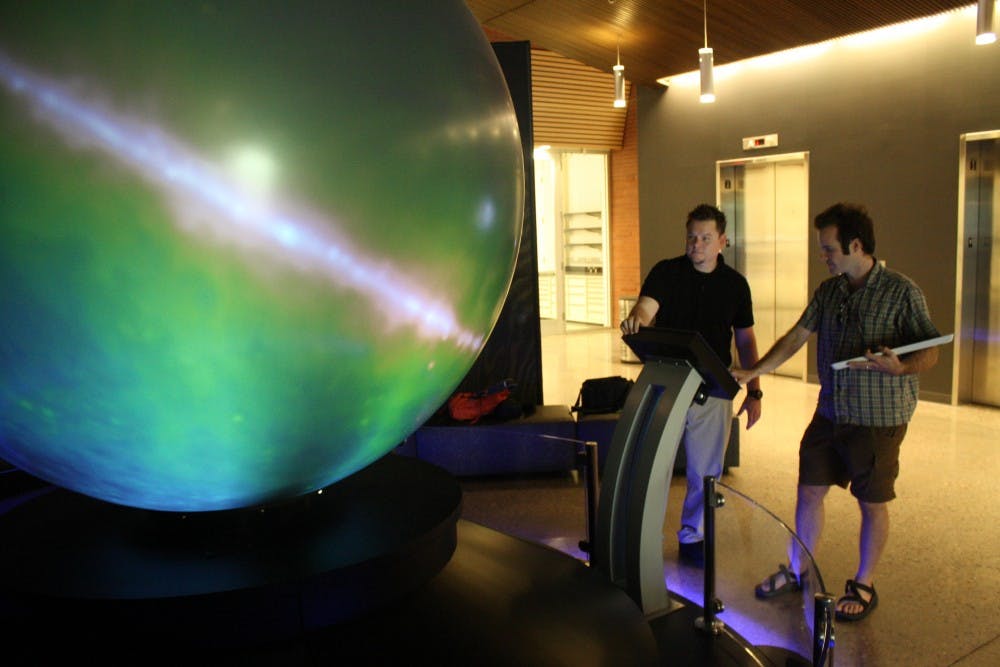 Danny Jacobs, a post doctorate in the School of Earth and Space Exploration and G. Paul Hudak, content manager of the gallery of scientific exploration, observe the low-frequency radio sky image. This image illustrates everything we know about the low-frequency radio sky, according to Dr. Jacobs. (Photo by Hector Salas Almeida)
Danny Jacobs, a post doctorate in the School of Earth and Space Exploration and G. Paul Hudak, content manager of the gallery of scientific exploration, observe the low-frequency radio sky image. This image illustrates everything we know about the low-frequency radio sky, according to Dr. Jacobs. (Photo by Hector Salas Almeida)
ASU's School of Earth and Space Exploration is working with a multinational team to see the first billion years after the Big Bang.
The team is using the Murchison Widefield Array, a low-frequency radio telescope which finished construction earlier this year, to scan the earlier universe.
Cosmology professor Judd Bowman, a project scientist for the MWA, said the project aims to look at the cosmic moments after the Big Bang, into a time when the universe was devoid of many of the celestial objects visible today.
“(We’re) attempting to study the early first billion years of our universe,” Bowman said. “My main goal is to understand how stars and galaxies first formed and how the universe evolved shortly after the Big Bang, when conditions were nearly the same everywhere.”
The research is set to look into the development of some of the first cosmic objects.
Postdoctoral research associate Daniel Jacobs said the assumption was that the universe began forming stars and galaxies locally rather than all at once. This would mean that one galaxy forming in one corner of the universe wouldn’t necessarily affect a star or other object forming in the other.
“When the Cosmic Microwave Background radiation was first emitted, it was one of the last times the universe did something all at once," he said. "We call it a global phase transition."
Jacobs said there is evidence to prove that this transition occurred, but there are still many questions about this point in time.
"But it turns out that there is no hydrogen between galaxies anywhere we look, so that means something global did actually happen much later than the CMB," he said. "And that’s what we’re trying to figure out. We know it happened, but when? When did this last phase of global transition occur? When did all the hydrogen disappear between all the galaxies? And at this point its completely unknown.”
Astrophysics graduate student Piyanat Kittiwisit said the telescope was not designed to actually see the first cosmic object, but to view its surroundings.
“The stuff that we are looking at with this telescope is actually not the stars themselves, but the environment around them," he said.
Kittiwisit is working to build a computer model based on the current data available from other telescopes in order to model what they hope to see from the MWA. They will later compare the model with the gathered data to see how it compares to reality.
“We are building a new telescope in Australia, the MWA, to observe the first star in the universe,” he said. “And basically, the data that you get out from that telescope would be in the new windows that no one ever observed.”
The MWA operates from 80 to 300 MHz, and is designed to pick up radio emissions that are approximately 0.1 percent as bright as the emission from our own Milky Way and fainter than the pollution from television and FM radios. Unlike many radio telescopes, the MWA is an interferometer comprised of many parts that act like a single telescope.
The MWA is a collaboration between Australia, India, New Zealand and the U.S. It is located at the Murchison Radio-astronomy Observatory in the western Australian outback.
Jacobs said the biggest advantage to using the MWA is the sheer area of the sky they are able to cover, as opposed to if they were using a standard radio telescope with a dish.
“We’ve gotten rid of the dish and put our antennas on the ground, but we put out a lot more of them,” he said. “The MWA in Australia has 2,000 of these things, and they’re all connected back to a supercomputer that combines all the signals together and makes images of the sky. So one of these, without any dish to focus the rays coming in from the sky, sees the entire sky all the way to the horizon.”
Jacobs said that while having a view of the entire sky is an advantage, the MWA picks up much interference. But the raw data doesn’t pose a huge problem because of continuing advances in technology.
“We can do this because computers are getting faster and faster,” he said. "So we are building telescopes that we can’t even process all the data when we’re building them. We have to assume that the computing power will be there when we get done with it.”
Reach the reporter at jcushma1@asu.edu or follow her on Twitter @jcushma1




